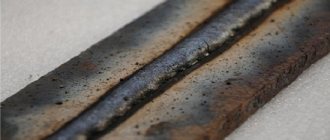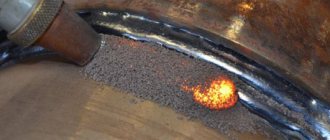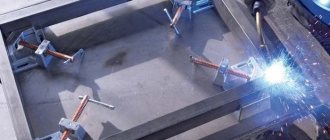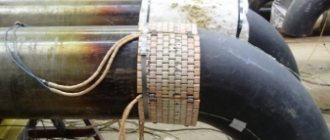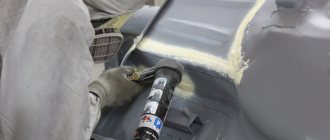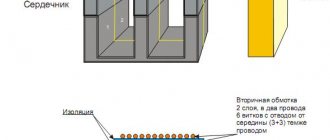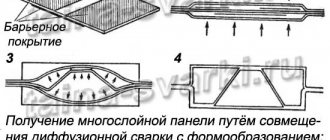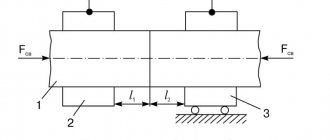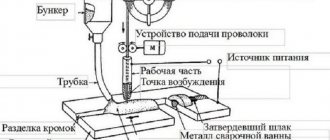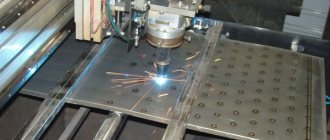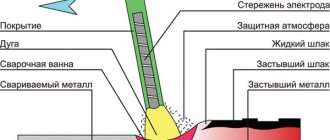Even perfect welding cannot protect the weld from damage. Sooner or later, this place becomes the weakest in the part and becomes deformed, so protective materials must be used during welding work. These include inert gases and fluxes. The latter are not so common in the domestic environment, but in production, submerged arc welding is very common. It will be discussed further below.
Features of submerged arc welding
Do not think that submerged arc welding is some completely new welding method. It was invented a long time ago, at the end of the 19th century, and the essence lies in the same use of filler wire and non-consumable electrodes. However, the equipment has constantly improved, and instead of gas covering the entire weld area, only flux is used. It has a powdery consistency and is poured over the seam.
Such a composition, under the influence of high temperatures, also begins to release gas, which will protect the parts being welded from oxides. When the powder burns out, only easily removable slag will remain, and if the product is not completely used, it can easily be saved until next time.
Before you do submerged arc cooking, you will need to select:
- mode;
- electrodes;
- filler wire.
Just like with any other welding work, you will need to properly shape the edges and degrease the parts. But here it will also be important to choose a flux, since it exists in different forms.
Flux protects the weld from oxides
Installation diagram for automatic submerged arc welding
The bare electrode wire 1, placed in the cassette 2, is moved to the product using the feed mechanism of the welding head.
The arc burns in a thick layer (50-70 mm) of glassy granular flux 3, which enters the welding zone from a special hopper 4.
When the machine or product moves forward, a weld seam 5 is formed, covered with a slag crust 6.
Most of the flux that remains unmelted is collected by the injection flux suction device 7 from the surface of the product and again enters the hopper.
The main feature of the described welding process is to improve the quality of the weld metal due to the fact that the flux provides a stable arc and protection of the welding zone from the influence of air.
Flux also helps slow down the cooling rate of the weld.
By selecting the composition of the flux, alloying of the weld metal can be carried out.
Fig.2 Installation diagram for automatic submerged arc welding
In automatic welding, the most widely used fluxes are slag systems based on silicates and oxides of manganese, calcium or magnesium.
Advantages and disadvantages
The submerged arc welding process itself has its positive and negative features. Among the advantages:
- Automation to achieve the most precise welds. Automation allows you to set all parameters electronically, so current, wire - everything is supplied and controlled by itself.
- The release of flux continues throughout the entire creation of the seam, which is why its efficiency is higher.
- Can be cooked with high current.
- The cooking speed is adjustable and can be very high.
- The weld pool can be increased.
- The seam is of high quality.
- The ability to assemble elements of complex structures quickly, efficiently and with little effort.
- Safety for welders, as they are not close to the parts being welded.
- You can use 2 electrodes simultaneously, powered by one current source.
Types of fluxes
These products can be divided into groups according to their chemical composition and method of creation. Flux can be saline, oxide or mixed. Here:
- Salt ones are better suited for electric welding of titanium or steel, nickel-plated or chrome-plated. Salt fluxes include fluoride and chloride salts.
- Oxide ones contain oxides of active metals, as well as silicon. This makes them best used for low carbon steels.
- Mixed ones are useful for multi-component alloys and many different metals. This is facilitated by a composition containing metal oxides and salts in different proportions.
There are only two manufacturing methods - fused or non-fused, which is also called ceramic. Fused ones are made from quartz sand, as well as manganese ore, which are mixed, melted, and then granules are formed. This flux is very suitable for low alloy steel.
The ceramic composition includes oxidizing agents and salts of amphoteric metals. First, they are crushed, then mixed with liquid glass until smooth. Then it is granulated and calcined. Such fluxes have the structure of a fine powder, and it is selected specifically for the grade of steel that will be worked with, since it only works with complex nickel or iron-nickel alloys.
Submerged Arc Welding Technology
In order for the welding process to proceed correctly, you need to choose the right automatic submerged arc welding technology. There are three basic methods:
- manual;
- auto;
- semi-automatic.
The process of manual cooking is clear. Manual equipment is used here, so the welder himself regulates the direction and speed of the electrode. The current strength and the supply of flux interacting with the electrode are adjusted using buttons directly on the device.
The semi-automatic method will allow you to automate only some processes, the rest require management. The way the wire is fed, the angle of the electrode, and the current strength are subject to an automatic process. At this time, the welder independently controls the movement of the arc. For semi-automatic devices, you can change the current supply parameters directly during operation.
In automatic submerged arc welding, the speed of movement of the electrode and its direction, as well as the wire feed speed, are set by software. Workers are needed here only to create that very welding program, as well as quality control.
Submerged arc welding diagram
All three of these methods, despite their differences, involve some common steps in submerged arc welding:
- Removal of oxide film.
- Fastening parts to the welding plate.
- Selection of settings and development of a plan.
- Selection of flux.
- Floating wire installation.
- Welding, where you need to carefully monitor the consumption of flux and wire to avoid damage.
After finishing the work, you just need to wait until the parts have cooled, clean the seam and put the flux into sealed containers.
The technology of the welding process using flux is described in detail in GOST 8713-79. It tells about all three methods, selection of materials, setup of equipment. It also shows all the types of welded joints that can be made using each of the three methods.
Our equipment
Our production uses a gantry submerged arc welding unit
and
welding machines
from leading manufacturers of welding equipment: Lincoln Electric, Kemppi, Z-Master, etc., which allow you to perform welding using various methods, including synergetic program, pulse welding, submerged arc welding, etc.
Gantry submerged arc welding machine
The gantry installation allows for automatic submerged arc welding of butt, lap, fillet and T-welds in the lower position, either with one welding head or two with synchronous start-stop activation, movement according to previously specified welding modes.
Submerged arc welding is used to produce welded structures from carbon, low and high alloy steels, copper, aluminum and their alloys.
The portal installation is a U-shaped mechanism moved (using servo drives) along rails. The portal contains two sets of welding heads, automatic NA-5 wire feed systems from Lincoln Electric, DC-1000 power supplies, flux recirculation mechanisms and a control panel.
In submerged arc welding, an electric arc burns under granular bulk material - flux. As the electrode wire melts, it is automatically fed into the welding zone. The heat of the arc melts the electrode wire and base metal, as well as part of the flux. A cavity is formed in the welding zone, filled with metal vapor, flux and gases. Molten flux, surrounding the gas cavity, protects the molten metal in the welding zone from harmful environmental influences.
Gantry submerged arc welding machine
Technical characteristics of the portal installation
| Number of welding heads, pcs. | 2 |
| Welding current regulation, A | 170–1250 |
| Maximum weld length, m | 36 |
| Maximum working width, mm | 3000 |
| Maximum lifting height of welding heads, mm | 1900 |
| Minimum welding speed, m/h | 7 |
| Maximum welding speed, m/h | 70 |
| Marching speed, m/h | 170 |
| Welded thicknesses, mm | 6–60 |
| Gantry submerged arc welding unit in operation | Automatic submerged arc welding |
| Characteristics of a submerged arc welding seam | Characteristics of a submerged arc welding seam |
Advantages of submerged arc welding:
- high quality weld
- high productivity and process stability
- minimal loss of electrode metal and complete absence of spatter
- maximum reliable protection of the welding zone
Welders
Welding machines used in our production
Welding mode selection
There are several modes that always need to be selected for each individual task.
| Metal thickness, mm | Wire diameter, mm | Welding current, A | Voltage, V | Welding speed, m/h |
| 3 | 2 | 250 — 500 | 28 — 30 | 48 — 50 |
| 5 | 2 | 400 — 450 | 28 — 30 | 38 — 40 |
| 10 | 5 | 700 — 750 | 34 — 38 | 28 — 30 |
| 20 | 5 | 750 — 800 | 38 — 42 | 22 — 24 |
| 30 | 5 | 950 — 1000 | 40 — 44 | 16 — 18 |
The modes from the table are suitable for low-carbon, medium-carbon and high-carbon steel.
Equipment used
To perform automatic submerged arc welding, the following technical equipment will be required:
- Welding plate. Installation of welding slabs will require a concrete base, since the slabs themselves are made of materials that are resistant to constant high temperatures and temperature changes.
- Floating wire. It usually has a thickness of 0.3 to 12 mm, and is made from the same material as the materials being welded.
- A non-consumable electrode that has a heavy alloy core and a ceramic braid.
- System supplying flux particles. It consists of a reservoir and a hose, the diameter of which will be sufficient to work with the electrode.
- A control system that is more developed in automatic devices and less developed in semi-automatic ones.
Welding tractor for automatic submerged arc welding
Automatic welding under a layer of flux is not difficult to perform, because most of the process will be automated, and the welder will only need to correctly configure the equipment and select the correct flux agent for welding.
What to look for when choosing equipment
The standard equipment for automatic welding with submerged surfacing is presented:
- welding power source;
- welding torch;
- a device that supplies electrode wire and flux (automatic welding head);
- a device that moves the workpiece to be welded or the welding head;
- flux collection system;
- proportional seam tracking system;
- video node.
The DC and AC welding current source must be designed for 100% of the cycle duration (10 minutes or more). Welding current values most often vary between 300-1500 A. The hopper connected to the welding head of the machine is usually equipped with a solenoid valve with automatic or manual control types.
Modern welding installations are characterized by the presence of a system for collecting unmelted flux with its subsequent supply inside the loading hopper. In practice, suspended welding heads (self-propelled and stationary), as well as welding tractors, are used.
When choosing, special attention is paid to the rated current (A) of the equipment and the diameter of the wire used (mm). It is important that the equipment has a current reserve of 30-50%.
